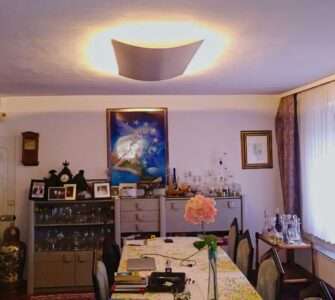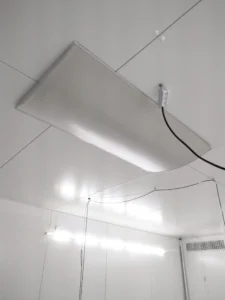
It is striking: only for infrared heaters is there a German industrial standard (DIN) that determines how efficient an infrared heater is. There is no standard for all other types of heaters. The basics:
Sunlight, the strongest source of infrared light, sends its rays with high energy to the earth and generates heat there. The efficiency of this primary energy is almost 99%. Infrared rays travel billions of light years through space without loss.
Due to the losses incurred when converting electricity into heat, the latest infrared heaters physically achieve a maximum efficiency of 70% (± 2.8%). A high efficiency is important. It is the first decision criterion for energy-saving heating.
AbegSun achieved a top score of 69.5% (± 2.8%) in the DIN EN IEC 60675-3 test at TU Dresden and was rated as one of the most efficient infrared heating elements.
Changes in material and aggregate state, e.g. the conversion of electricity into heat or the transfer of heat to sheet metal, glass, slate or marble, always cost energy. Even painting causes losses. If an efficiency of almost 100 % is quoted for infrared heaters, this is wrong. It is confused with the efficiency of primary energy - see below ↓ …..
Primary energy – these include coal, wood, natural gas, petroleum, nuclear fuel, peat and renewable energy sources.
Secondary energy – in refineries or power plants it is produced from primary energy by converting the state of aggregation, e.g. petrol or electricity.
Final energy - This can already be utilised by the consumer. It is lower than secondary energy due to conversion, transmission and utilisation losses.
Useful energy – this is the energy that is available to the end user after conversion from final energy to a heating system in a room. The useful energy is less than the final energy because the conversion of energy from final energy involves losses.
The amount of energy available can be determined by calculating the efficiency. According to the DIN EN IEC 60675-03 In Germany, the efficiency is tested and calculated by the TU Dresden and given as a % value.
The efficiency is always less than 100% due to conversion losses. Losses occur when changing states of matter, e.g. from liquid to gaseous or when converting electrical energy into heat energy. This is why a maximum value of 70% (± 2.8%) can be achieved with infrared heaters (statement from the TU Dresden in accordance with DIN). Maximum efficiency is the basic requirement for the lowest possible energy consumption. It is the most important base value for determining the efficiency of a heating system.
The heating efficiency of the AbegSun infrared heating elements of 69.5% (± 2.8%) has also been verified in practice. Take a look at the results of a daily consumption measurement at .......⇒.
Data on the annual coefficient of performance (COP) of a heat pump is often interpreted by “experts” and journalists as meaning that 3-5 times more energy is supposedly gained than is supplied. If that were the case, we would no longer have any energy problems in the world, but would have invented a perpetual motion machine. So everyone should bear in mind that a wrong decision about the duration of years of heating periods can cost an enormous amount of money! Siehe auch „Unsere Philosophie“ ……..⇒
 AbegSun efficiency test TU Dresden
AbegSun efficiency test TU DresdenOf all the types of heating, infrared heating is the only one for which there is a set test according to DIN to determine efficiency. The picture on the left shows an AbegSun heating element during the efficiency test at the TU Dresden.
In every heating system, there are physical losses between the input energy and the usable final energy that cannot be avoided. Every change of aggregate state, from solid to liquid or from electricity to heat, reduces the efficiency; every change of material in which the energy has to be transferred also reduces the efficiency. This means that a heater covered by a front sheet metal housing always suffers losses. Even painting reduces efficiency.
AbegSun is equipped with a 0.8 mm thick heating foil that has no panelling or coating on the front. This results in a short heating time with a radiation temperature of 100°C after 120 seconds (laut Test certificate from TU Dresden).
Long heat-up times result in losses because the full power is consumed from the outset, but the heat only develops slowly. In addition, there is no need for the preheating required with all other heaters. There is also no need to set a basic temperature. If nobody is there, the heating is off. Consumption is ZERO.
According to scientists and the DIN standard, the maximum physically achievable limit for infrared heating elements is a maximum of 70% (± 2.8%).
According to DIN, AbegSun has an efficiency of 69.5% (± 2.8%) out of a physically achievable 70%. This makes AbegSun infrared heating one of the most efficient in the world. This means that it is possible to achieve the lowest energy costs. These are only influenced positively or negatively by your own heating behavior.
The cheapest radiator is always the one with the highest efficiency – regardless of the purchase price! (Table with energy losses in the event of poor efficiency) ...... ⇒


This website uses cookies to improve your experience. We'll assume you're ok with this, but you can opt-out if you wish. Read more
| Name | Domain | Purpose | Expiry | Type |
|---|---|---|---|---|
| _ga | abeg.de | Google Universal Analytics long-time unique user tracking identifier. | 2 years | HTTP |
| sbjs_migrations | abeg.de | Sourcebuster tracking cookie | 55 years | HTTP |
| sbjs_current_add | abeg.de | Sourcebuster tracking cookie | 55 years | HTTP |
| sbjs_first_add | abeg.de | Sourcebuster tracking cookie | 55 years | HTTP |
| sbjs_current | abeg.de | Sourcebuster tracking cookie | 55 years | HTTP |
| sbjs_first | abeg.de | Sourcebuster tracking cookie | 55 years | HTTP |
| sbjs_udata | abeg.de | Sourcebuster tracking cookie | 55 years | HTTP |
| sbjs_session | abeg.de | SourceBuster Tracking session | Session | HTTP |
| tk_or | abeg.de | JetPack analytical cookie that stores a randomly-generated anonymous ID. This is only used within the admin area and is used for general analytics tracking. | 5 years | HTTP |
| tk_r3d | abeg.de | JetPack analytical cookie that stores a randomly-generated anonymous ID. This is only used within the admin area and is used for general analytics tracking. | 3 days | HTTP |
| tk_lr | abeg.de | JetPack analytical cookie that stores a randomly-generated anonymous ID. This is only used within the admin area and is used for general analytics tracking. | 1 year | HTTP |
| tk_ai | abeg.de | JetPack analytical cookie that stores a randomly-generated anonymous ID. This is only used within the admin area and is used for general analytics tracking. | 5 years | HTTP |
| tk_qs | abeg.de | JetPack analytical cookie. This is used for general analytics tracking. | Session | HTTP |
| IDE | doubleclick.net | Google advertising cookie used for user tracking and ad targeting purposes. | 2 years | HTTP |
| Name | Domain | Purpose | Expiry | Type |
|---|---|---|---|---|
| __cf_bm | chatgpt.com | Generic CloudFlare functional cookie. | Session | HTTP |
| __cflb | chatgpt.com | Generic CloudFlare functional cookie. | Session | HTTP |
| Name | Domain | Purpose | Expiry | Type |
|---|---|---|---|---|
| _ga_KHX87M29Q7 | abeg.de | --- | 2 years | --- |
| _ga_DSRJTX116M | abeg.de | --- | 2 years | --- |
| _gcl_au | abeg.de | --- | 3 months | --- |
| test_cookie | doubleclick.net | Google advertising domain. | Session | HTTP |


